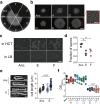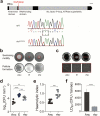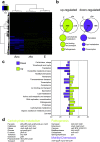Adaptation of Bacillus thuringiensis to Plant Colonization Affects Differentiation and Toxicity
- PMID: 34636664
- PMCID: PMC8510532
- DOI: 10.1128/mSystems.00864-21
Adaptation of Bacillus thuringiensis to Plant Colonization Affects Differentiation and Toxicity
Abstract
The Bacillus cereus group (Bacillus cereus sensu lato) has a diverse ecology, including various species that are vertebrate or invertebrate pathogens. Few isolates from the B. cereus group have however been demonstrated to benefit plant growth. Therefore, it is crucial to explore how bacterial development and pathogenesis evolve during plant colonization. Herein, we investigated Bacillus thuringiensis (Cry-) adaptation to the colonization of Arabidopsis thaliana roots and monitored changes in cellular differentiation in experimentally evolved isolates. Isolates from two populations displayed improved iterative ecesis on roots and increased virulence against insect larvae. Molecular dissection and recreation of a causative mutation revealed the importance of a nonsense mutation in the rho transcription terminator gene. Transcriptome analysis revealed how Rho impacts various B. thuringiensis genes involved in carbohydrate metabolism and virulence. Our work suggests that evolved multicellular aggregates have a fitness advantage over single cells when colonizing plants, creating a trade-off between swimming and multicellularity in evolved lineages, in addition to unrelated alterations in pathogenicity. IMPORTANCE Biologicals-based plant protection relies on the use of safe microbial strains. During application of biologicals to the rhizosphere, microbes adapt to the niche, including genetic mutations shaping the physiology of the cells. Here, the experimental evolution of Bacillus thuringiensis lacking the insecticide crystal toxins was examined on the plant root to reveal how adaptation shapes the differentiation of this bacterium. Interestingly, evolution of certain lineages led to increased hemolysis and insect larva pathogenesis in B. thuringiensis driven by transcriptional rewiring. Further, our detailed study reveals how inactivation of the transcription termination protein Rho promotes aggregation on the plant root in addition to altered differentiation and pathogenesis in B. thuringiensis.
Keywords: Arabidopsis thaliana; Bacillus thuringiensis; experimental evolution; pathogenesis; plant-microbe interaction.
Figures







Similar articles
-
Adaptive laboratory evolution reveals regulators involved in repressing biofilm development as key players in Bacillus subtilis root colonization.mSystems. 2024 Feb 20;9(2):e0084323. doi: 10.1128/msystems.00843-23. Epub 2024 Jan 11. mSystems. 2024. PMID: 38206029 Free PMC article.
-
Comparative Genomics of Bacillus thuringiensis Reveals a Path to Specialized Exploitation of Multiple Invertebrate Hosts.mBio. 2017 Aug 8;8(4):e00822-17. doi: 10.1128/mBio.00822-17. mBio. 2017. PMID: 28790205 Free PMC article.
-
Insect pathogens as biological control agents: Back to the future.J Invertebr Pathol. 2015 Nov;132:1-41. doi: 10.1016/j.jip.2015.07.009. Epub 2015 Jul 27. J Invertebr Pathol. 2015. PMID: 26225455 Review.
-
Adaptation and phenotypic diversification of Bacillus thuringiensis biofilm are accompanied by fuzzy spreader morphotypes.NPJ Biofilms Microbiomes. 2022 Apr 13;8(1):27. doi: 10.1038/s41522-022-00292-1. NPJ Biofilms Microbiomes. 2022. PMID: 35418164 Free PMC article.
-
Insecticidal crystal proteins of Bacillus thuringiensis.Microbiol Rev. 1989 Jun;53(2):242-55. doi: 10.1128/mr.53.2.242-255.1989. Microbiol Rev. 1989. PMID: 2666844 Free PMC article. Review.
Cited by
-
Establishment of a transparent soil system to study Bacillus subtilis chemical ecology.ISME Commun. 2023 Oct 14;3(1):110. doi: 10.1038/s43705-023-00318-5. ISME Commun. 2023. PMID: 37838789 Free PMC article.
-
Organic vs. Conventional Milk: Uncovering the Link to Antibiotic Resistance in Bacillus cereus sensu lato.Int J Mol Sci. 2024 Dec 17;25(24):13528. doi: 10.3390/ijms252413528. Int J Mol Sci. 2024. PMID: 39769288 Free PMC article.
-
Evolving a plant-beneficial bacterium in soil vs. nutrient-rich liquid culture has contrasting effects on in-soil fitness.Appl Environ Microbiol. 2025 Apr 23;91(4):e0208524. doi: 10.1128/aem.02085-24. Epub 2025 Mar 11. Appl Environ Microbiol. 2025. PMID: 40067020 Free PMC article.
-
Termination factor Rho mediates transcriptional reprogramming of Bacillus subtilis stationary phase.PLoS Genet. 2023 Feb 3;19(2):e1010618. doi: 10.1371/journal.pgen.1010618. eCollection 2023 Feb. PLoS Genet. 2023. PMID: 36735730 Free PMC article.
-
Rho-dependent termination: a bacterial evolutionary capacitor for stress resistance.Transcription. 2025 Apr-Jun;16(2-3):176-189. doi: 10.1080/21541264.2025.2474367. Epub 2025 Mar 5. Transcription. 2025. PMID: 40044630 Free PMC article. Review.
References
Grants and funding
LinkOut - more resources
Full Text Sources

